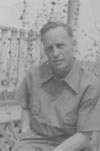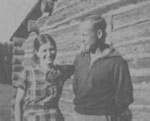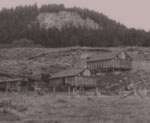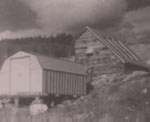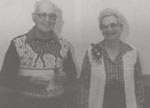Before the coming of Europeans, Native Americans from such tribes
as the Crow, Arapahoe, Shoshone, Blackfoot and Sioux were aware of
a strange white clay to which they attributed healing power, calling
it "Ee-Wah-Kee" -- The Mud That Heals.
The story of Ee-Wah-Kee is fascinating. An old newspaper story describes
an event that occurred during the final buffalo hunt of the noted
Shoshone Chief, Washakie, about 1888. A white newspaperman accompanied
the Shoshones on this hunt, and fell ill. Washakie's medicine man
chanted incantations, rubbed the sick man with herbs, and made him
drink some water in which a whitish clay was dissolved. The reporter
drank the mixture, slept for several hours, and awoke feeling completely
well. Testimonies of the clay's mysterious usefulness for a wide variety
of uses have spread widely since then.
The clay is now called Pascalite after a French-Canadian trapper
and prospector, Emile Pascal, who first began mining it. Pascal, trapping
in the Big Horn Mountains about 1930, found his badly chapped hands
healed quickly when plastered with Pascalite. He tried it on his face
for snow burn, and was amazed at the result. He filed a mining claim
and began telling people about the white mud Eventually Pascalite
would be used in soap and toothpaste, applied as a poultice to insect
bites, sunburns, infections, cold sores and acne, and as a suppository
for hemorrhoids. Users found it a potent skin cleanser and conditioner,
drank it for heartburn and ulcers and swallowed capsules of Pascalite
as a natural mineral and dietary supplement. Ranchers and veterinarians
applied it to wounds and infections on livestock. Testimonies of the
clay's medical and cosmetic usefulness spread. It has been used locally
for sixty years, and, increasingly, world-wide as a natural, homeopathic
remedy for what ails you.
PASCALITE is a rare calcium bentonite, formed thirty million years
ago as the froth and foam of the firey and convulsive era atop the
Big Horn Mountains in Wyoming. Over the centuries, it captured the
calcium from that limestone formation, and many other minerals (now
known to be vital to life) in trace amounts migrated into it --manganese,
cobalt, copper, etc... Slowly cooling temperatures converted these
to oxides, readily absorbed in the human metabolism. It was further
enriched by abundant plant life, and tissues, bones, hides, and hair
of many prehistoric animals, adding their proteins and amino acids.
The valley near the top of the Big Horn Mountains, South Paint Rock
Valley, was for a vast period of time a favorite camping ground and
arrow-chipping ground for various Indian tribes - the Crows, Arapahos,
Shoshones, Blackfoot and Sioux. They knew about and used PASCALITE,
which they called "Ee-Wah-Kee" ("The -Mud-That-Heals").
Some tribes even offered it for bartering purposes at the various
rendezvous, such as the Green River Rendezvous, where trappers, traders
and Indians all congregated once a year to trade furs.
PASCALITE was unknown to the white man until Emile Pascal, a trapper,
found it by accident about 1930. He accidentally got his badly chapped
hands coated with PASCALITE. His hands improved, and with continued
use of the clay, healed. Pascal filed mining claims on it, and his
friends began using it at his urging.
Ray Pendergraft is president of PASCALITE, Inc now and has many interesting
stories to tell. He recalls a story he found in an old newspaper:
"Chief Washakie of the Shoshone tribe, on his last buffalo hunt, about
1888, had a white newspaperman with him. After the party had hunted
over the Owl Creek Mountains in Wyoming, traveling north from the
Wind River Reservation to the Greybull River at the foot of the Big
Horn Mountains, the newsman got very sick. Chief Washakie ordered
his medicine man to cure him. The medicine man muttered some incantations
over him, rubbed his abdomen and chest with some herb, then gave him
some of the white powder from the mountains in water to drink. After
ingesting this decoction (PASCALITE), the man felt soothed and shortly
fell into a sleep which lasted several hours. When he awoke, he was
completely well."
Ray also recalls "back in the 'golden days' of our mining venture
- in the 1930's - we had the entire mountain (that section of it containing
PASCALITE) to our-selves. It was our kingdom in which we were for
the most part the only subjects. Few people ever came down into that
deep valley - it was off the beaten trail; the road was rocky, rough,
and on occasion impassable... and this was as close to Shangri La
as civilized man could come in the 20th century.
"We had a 50-gallon iron barrel fastened to one of the buildings
for an outdoor shower. We would fill it by hose and let the sun warm
it; it was always available along with the PASCALITE to make a thick
paste to be smeared over our scratched or bruised limbs, then rinsed
off with the needle-sharp fingers of water, still cold enough to bring
forth a gasp, and a resulting feeling of well-being that bordered
on euphoria!"
Ray explains how he came into the picture when, as an unemployed
coal miner in the 1930's he sought for and found a job as the mine
foreman for Labbe Products, which was the company formed to market
this product - then called "Life Mud". The company had acquired a
processing plant in Worland and a factory in Casper. It manufactured
toothpaste. hair pomade, rectal suppositories, ointment, poultice and soap.
When the company (faced with accumulated debts and public indifference)
failed, Ray Pendergraft bought a half interest in the mining claims
from Emile Pascal for a nominal sum plus his agreement to do the assessment
and other mining work, file labor proofs, etc.
"During the fifties I tried vainly to get large drug and cosmetic
companies interested in the material we had renamed PASCALITE (after
Pascal). We finally leased it to a mining man, but after one year
he was unable to meet the advance royalty payment and we cancelled
his lease. "This happened several more times; each time we learned
from the previous experiences, obtained a better lease and felt the
new company would manage to succeed in marketing PASCALITE. History
kept repeating itself, however, and the lessees could not develop
enough working capital to do what was necessary to get the product
on the market.
"Meanwhile, people who became interested used the product and reported
their results. We were gradually building up a file on its uses with
sometimes dramatic results being reported."
Finally in 1970 Ray was able to get an article published in a national
publication called "Beyond," and he began to get re-quests from all
over for the product. It was sent out to them with no claims made
and the signed understanding that it was being obtained and used at
their own risk and for research purposes only. Other magazines picked
up his story, and the demand continued.
"We do not make any claims for PASCALITE," explains Ray, "nor do
we prescribe it or offer it as an agent for any treatment. But results
of experimental usage of PASCALITE, as done by a testing Company of
Hoboken, New Jersey, private testing companies, medical doctors, and
users who, acknowledging that no claims were made for it, willingly
used it at their own risk, cannot be ignored. I have documentary
support of all cases in my files."
 The
Pascalite Story
The
Pascalite Story